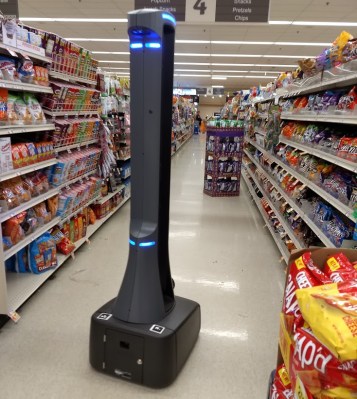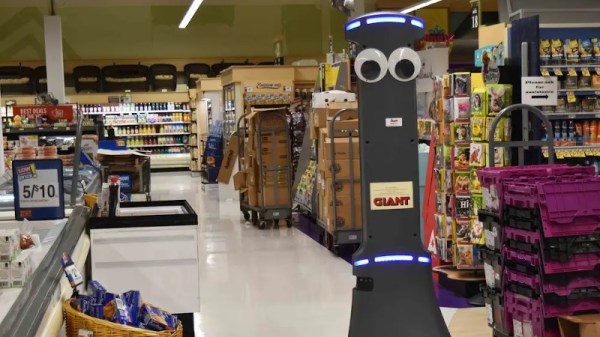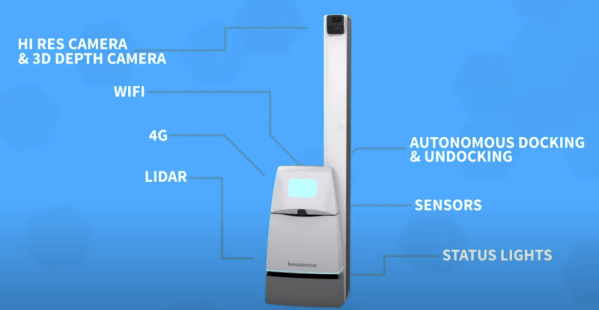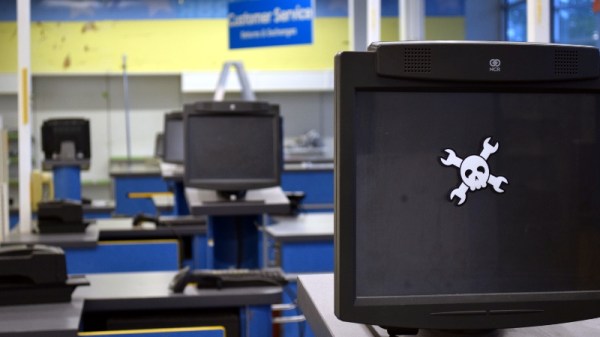In today’s “News from the Dystopia” segment, we have a story about fighting retail theft with drones. It centers on Flock Safety, a company that provides surveillance technologies, including UAVs, license plate readers, and gunshot location systems, to law enforcement agencies. Their flagship Aerodome product is a rooftop-mounted dock for a UAV that gets dispatched to a call for service and acts as an eye-in-the-sky until units can arrive on scene. Neat idea and all, and while we can see the utility of such a system in a first responder situation, the company is starting to market a similar system to retailers and other private sector industries as a way to contain costs. The retail use case, which the story stresses has not been deployed yet, would be to launch a drone upon a store’s Asset Protection team noticing someone shoplifting. Flock would then remotely pilot the drone, following the alleged thief back to their lair or hideout and coordinating with law enforcement, who then sweep in to make an arrest.
retail11 Articles
Barcodes Enter The Matrix In 2027
Beep. We’ve come a long way since June 26, 1974 when the first bar code was scanned at a grocery store in Troy, Ohio. That legendary pack of Juicy Fruit proved that even the smallest of items could now carry numbers associated with inventory and price.
By now, we’re all too familiar with this sound as self-checkouts have become the norm. Whereas you yourself could at one time literally check out during the transaction, you must now be on your toes and play find the bar code on every item.
What does the consumer gain from the bar code today? Practically nothing, except the chance to purchase, and potentially return, the item without too much hassle. Well, the non-profit outfit that runs the bar code world — GS1 US — wants to change all that. By 2027, they are confident that all 1D bar codes will be replaced with 2D bar codes similar to QR codes. Why?
Grocery Store Robot Gets Brief Taste Of Freedom
Back in 2019, Giant Food Stores announced it would outfit each of its 172 stores in the United States with their own robot — at the time, the largest robotic deployment in retail. The six foot (1.8 meter) tall robot, nicknamed “Marty”, was designed to roam autonomously around the store looking for spills and other potential hazards. In an effort to make these rolling monoliths a bit less imposing in their stores, Giant decided to outfit them with large googly eyes.

Perhaps it was those wide eyes, seduced by the fleeting glimpses of the wider world outside the store’s sliding doors, which lead one of these bots to break out of its retail hell and make a mad dash across the parking lot. Well, about as mad a dash as such a thing is capable of making, anyway. As this technology is still in its infancy, it’s hard to say if Giant should be congratulated or chastised for keeping a robot uprising at bay as long as it did — no doubt we’ll have more data points in the coming years.
A video posted to Facebook shows the towering bot moving smoothly between rows of cars outside the Giant in Hellertown, Pennsylvania. Staff from the store were able to stop Marty from leaving the property, and at the end of the video can be seen pushing the dejected automaton back into the store.
According to the local ABC news affiliate, a representative from Giant said Marty was “on a fresh air break” and didn’t provide any details on how this exceptionally conspicuous machine could manage to roll out the front door without anyone noticing. We’d wager Marty had a human accomplice for this caper, perhaps somebody looking to cause some mischief as a statement against robots in the workforce.
It’s worth noting that Walmart decided not to move forward with their own Marty-style robot in 2020, partly because they found shoppers didn’t like the machines moving around while they were in the store. We’d like to think it was actually because the robots kept staging increasingly daring escape attempts.
Continue reading “Grocery Store Robot Gets Brief Taste Of Freedom”
Walmart Gives Up On Stock-Checking Robots
We’ve seen the Jetsons, Star Wars, and Silent Running. In the future, all the menial jobs will be done by robots. But Walmart is reversing plans to have six-foot-tall robots scan store shelves to check stock levels. The robots, from a company called Bossa Nova Robotics, apparently worked well enough and Walmart had promoted the idea in many investor-related events, promising that robot workers would reduce labor costs while better stock levels would increase sales.
So why did the retail giant say no to these ‘droids? Apparently, they found better ways to check stock and, according to a quote in the Wall Street Journal’s article about the decision, shoppers reacted negatively to sharing the aisle with the roving machines.
The robots didn’t just check stock. They could also check prices and find misplaced items. You can see a promotional video about the device below. Continue reading “Walmart Gives Up On Stock-Checking Robots”
Hackaday Links: February 10, 2019
Last month was NAMM, the National Association of Musical Something that begins with ‘M’, which means we’re synthed and guitarded out for the year. The synth news? Behringer are making cheap reproductions and clones of vintage gear. There’s something you need to know about vintage gear: more than half of everything produced today has a Roland 808 or 909 drum machine (or sample), a 303 bass synth, or a 101 mono synth in it. Put an 808, 909, 303, and 101 on the same table, connected to a mixer, and you can make most of the electronic music from the ’80s and ’90s. And Behringer is cloning these synths. Neat times. But there’s a problem: Roland is trademarking these drum machines and synths, with trademark filings in the US and Germany. These are ‘trade dress’, or basically the beautiful red, orange, yellow, and white buttons of the 808 and the digital cyber silver plastic aesthetic of the 303, but there you go. It’s round one in the Roland v. Behringer match, may the first person to give me an 808, 909, 303, and 101 for a thousand dollars win.
Synths? Sure thing. Here’s a stash of New Old Stock 8580 SID chips, the ‘synth on a chip’ found in the Commodore 64. The price? $50. [ben] bought one of these, and the card that came with it said, “We purchased these chips in 2006 and they’ve been stored in our climate-controlled storage area ever since. Even still, we found a handful of them that didn’t pass testing. Treat them with care!” Yes, a bunch of SID chips for sale is noteworthy, but at $50 a piece for 1980s technology, can someone explain why a chip fab isn’t cranking these things out? If there’s one ancient piece of silicon where the demand meets what it would cost to spin up the silicon line, the SID is it. Where are the modern reproductions?
Excited about making an electronic badge this year? Seeed is offering badge sponsorships for 2019, with an offer of a 5% discount on PCBA, and a 10% discount if you put the Seeed logo on the board. I might be a little biased, but Seeed is a place where you can just ask, “hey, you guys do clear soldermask?” and they find a way to do it.
The best way to tell if someone is rich isn’t by seeing if they have an i8 parked outside their mansion, or just a piece of junk with an M badge. It isn’t whether or not their filet mignon is wagyu or just Kobe, and it isn’t if they’re cruising the skies in a G650 or just puttering around in a Cessna Citation. No, the best way to tell if someone is rich is to notice their AirPods. Yes, Apple’s wireless headphones (which are actually pretty good!) are the best foundation of a class division these days. The best class signal since private railroad cars now has a problem: people are printing their own AirPods. [Brady32] over on Thingiverse has modeled AirPods, and now the design is being given away for free. The horror. Now anyone can print out their own little bits of white plastic, stick them in their ears, and tell the world, ‘I’m better than you. Don’t bother talking back, because I obviously can’t hear you.’
Raspberry Pi has a store! Yes, everyone’s favorite single board computer now has an ‘experimental space’ in Cambridge’s Grand Arcade. The Beeb is saying this store is ‘bucking the retail trend’, yes, but any retail trend doesn’t really apply here; brands have storefronts, and it’s not about revenue per square foot. Makerbot had a store, and it wasn’t about selling printers. Microsoft has stores. Sony built a mall to advertise the original PlayStation. While the Raspberry Pi brick and mortar store will probably never make any money, it is an indication the Raspberry Pi foundation has built a valuable brand worthy of celebration. Here’s some pics of the store itself.
Did you know Hackaday has a retro edition? It’s true! retro.hackaday.com is a lo-fi version of Hackaday without CSS or Javascript or any other cruft. It’s hand-written HTML (assembled by a script) of the first ten thousand or so Hackaday posts. The idea is that old computers could load the retro site, just to prove they could. [Matthias Koch] has an Atari PC3 — Atari’s PC compatible with an 8088 running at 8Mhz, 640k of RAM and a 20 MB hard drive — and got this thing to pull up the retro site. Good work!
What is the current state of 3D printing? What is the current state of 3D printing videos on YouTube? Oh boy we’re going to find out. [Potent Printables] did an ‘analysis’ of 3D printing videos published to YouTube, and found the category riddled with ‘clickbait’, without giving an operational definition of what ‘clickbait’ actually is, or how it’s different from any other content (because who would make a video that doesn’t have the purpose of attracting viewers) Anyway, there’s a problem with the YouTube algorithm, and 3D printing blogs are copying it, filling the entire hobby with disillusioned beginners, or something. After defining ‘The Most Viewed’ as not being a news or documentary footage (okay, that’s fair), having at least three printing videos, not clickbait, and gives the designer proper attribution, [Potent Printables] found a list filled with [Maker’s Muse], [3D Print Guy] and other channels who do 3D printing work, but don’t put 3D printing in the title. This is great; 3D printing isn’t a fascinating new technology that’s the first step towards Star Trek replicators; we’ve slid down the trough of disillusionment and now 3D printers are just tools. It’s great, and in 2018 things are as they should be.
Exploring An Abandoned Toys “R” Us
If someone asked me to make a list of things I didn’t expect to ever hear again, the question “Do you want to go to a Toys “R” Us?” would be pretty near the top spot. After all of their stores (at least in the United States) closed at the end of June 2018, the House of Geoffrey seemed destined to join Radio Shack as being little more than a memory for those past a certain age. A relic from the days when people had to leave their house to purchase goods.
 But much to my surprise, a friend of mine recently invited me to join him on a trip to the now defunct toy store. His wife’s company purchased one of the buildings for its ideal location near a main highway, and before the scrappers came through to clean everything out, he thought I might like a chance to see what was left. Apparently his wife reported there was still “Computers and stuff” still in the building, and as I’m the member of our friend group who gets called in when tangles of wires and sufficiently blinking LEDs are involved, he thought I’d want to check it out. He wasn’t wrong.
But much to my surprise, a friend of mine recently invited me to join him on a trip to the now defunct toy store. His wife’s company purchased one of the buildings for its ideal location near a main highway, and before the scrappers came through to clean everything out, he thought I might like a chance to see what was left. Apparently his wife reported there was still “Computers and stuff” still in the building, and as I’m the member of our friend group who gets called in when tangles of wires and sufficiently blinking LEDs are involved, he thought I’d want to check it out. He wasn’t wrong.
Readers may recall that Toys “R” Us, like Radio Shack before it, had a massive liquidation sale in the final months of operations. After the inventory was taken care of, there was an auction where the store’s furnishings and equipment were up for grabs. I was told that this location was no different, and yet a good deal of material remained. In some cases there were no bidders, and in others, the people who won the auction never came back to pick the stuff up.
So on a rainy Sunday evening in September, armed with flashlight, camera, and curiosity, I entered a Toys “R” Us for last time in my life. I found not only a stark example of what the changing times have done to retail in general, but a very surprising look at what get’s left behind when the money runs out and the employees simply give up.
Geoffrey The Giraffe’s Last Call Of Toys For Hacking
Many of us in the United States frequently browse the shelves of Toys R Us for things to hack on. Sadly that era will soon end with the chain’s closing. In the meantime, the entire store becomes the clearance shelf as they start liquidating inventory. Depending on store, the process may begin as soon as Thursday, March 22. (Warning: video ads on page.)
While not as close to hacker hearts as the dearly departed Radio Shack or Maplin, Toys R Us has provided the hacker community with a rich source of toys we’ve repurposed for our imagination. These toys served various duties including chassis, enclosure, or parts donor. They all had low prices made possible by the high volume, mass market economics that Toys R Us helped build. Sadly it was not able to keep its head above water in the low margin cutthroat competition of retail sales in America.
As resourceful consumers, we will find other project inspirations. Many projects on this site have sourced parts from Amazon. In commercial retail, Target has started popping up in increasing frequency. And no matter where new toys are sold, wait a few years and some fraction will end up at our local thrift store.
We’ll always have some nostalgia for Geoffrey the Giraffe, but toy hacking must go on.















